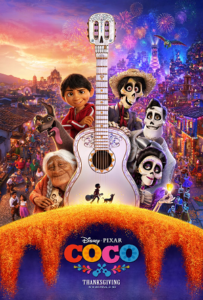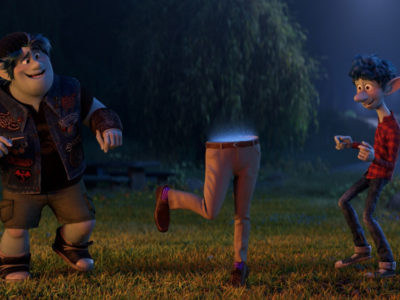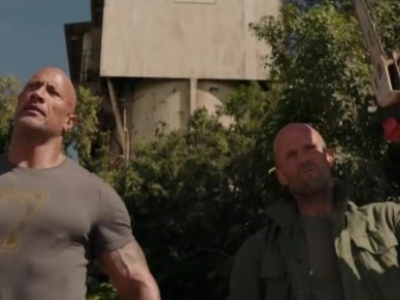Review| Coco
 Coco, Pixar Animation Studios’ 19th animated feature, is another solid, delightful masterpiece for the hit-making studio. Like most of Pixar’s best films, Coco hits all the notes to make it an amazing piece of storytelling: a compelling plot, great characters to follow, a wonderful universe to explore, and themes about life that appeal to everyone.
Coco, Pixar Animation Studios’ 19th animated feature, is another solid, delightful masterpiece for the hit-making studio. Like most of Pixar’s best films, Coco hits all the notes to make it an amazing piece of storytelling: a compelling plot, great characters to follow, a wonderful universe to explore, and themes about life that appeal to everyone.
Director Lee Unkrich (who also helmed the amazing Toy Story 3) has crafted yet another interesting and sincere family adventure, and all of Pixar should be very proud.
Coco’s thematic richness is the reason why I think this film will have lasting universal appeal. The themes are deep, and it’s very difficult to discuss all of them in this review. However, I will discuss what is probably the film’s most prominent thematic string: the importance of family.
SPOILERS AHEAD!
The Good: Everything
Simply put, virtually everything about Coco is wonderful – the story being at the top of the list. Lee Unkrich and his team have created a universal story that is one of Pixar’s most compelling. Based on interviews I’ve read with Unkrich, the story was really the thing that guided the making of the film, as it should be. I know this is storytelling 101, but so many modern filmmakers just don’t get this most basic of axioms.
Coco‘s story can be understood by everyone. It’s not a Mexican story, but a story that happens takes place in Mexico. It’s about the Rivera family, not Mexican culture. There is no cultural self-awareness in the narrative, which has been one of my frustrations with mainstream films that have attempted to showcase another culture.
This respect for (not condescension to) culture is also inherent in the design of the film, which is brilliant. Unkrich and the rest of the Pixar team really did their homework when it comes to capturing the look and feel of rural Mexico and the Dia de los Muertos festivities. It appears so effortless onscreen and therefore doesn’t call attention to itself.

Every background has such rich textures and details. The design of the Land of the Dead specifically has a sense of visual playfulness with themes of death. I likened to the design to the morbid whimsy of Tim Burton’s Beetlejuice but less macabre. The design also has an amazing timelessness to it, as it can’t be pinpointed to any decade (even the technology is a jumble of different eras).
The emotion that comes with the story is very genuine and doesn’t seem forced, overly sentimental or hackneyed. There were several times I genuinely teared up over scenes because I was so involved with the story. This emotion is also felt in the vocal performances, which all come off as authentic – especially Anthony Gonzalez, who plays the film’s protagonist, Miguel Rivera. What a voice, too!
Speaking of voices, the music of Coco was outstanding. Michael Giacchino infuses the orchestrations with traditional Mexican musical sensibilities. The songs flow so well with the score and propel the story forward, as they should (again, storytelling 101). Even the orchestrations of “Remember Me” reveal a plot point (the empty, bombastic ballad of Ernesto de la Cruz versus Hector’s quiet, heartfelt lullaby).
The Bad: Skeletons and Snowmen
If there is one artistic choice that struck me as off-putting in Coco, it was the employment of a jarring and artificial shaky-cam effect. The effect was extensively used in the sequence where Miguel first discovered he could see the dead in the graveyard. It was more distracting than normal shaky-cam because it’s artificial (there was no camera to shake). It ended up looking like the ride film on a simulator and felt forced.

There was a design choice that bothered me: the aging of the dead. There seemed to be inconsistent rules regarding how Miguel’s late relatives looked in their skeletal forms. Some appeared older and younger with no real logic. Mama Coco retained her elderly appearance and gait, yet her parents seemed younger (I can understand that Hector would be young because he died that way, but what about Imelda?). For a film that spent so much time and effort building a rich world with rules and consequences, this was a glaring oversight.
The most egregious aspect of the Coco moviegoing experience wasn’t the film itself but sitting through the 21-minute “short” (yes, 21 minutes) before the feature, Olaf’s Frozen Adventure. It was just…too much. Too many songs for so short a film. Too many cynical, postmodern holiday insults (mostly directed at Christmas). It was obnoxious and compounded all the aspects of the original Frozen that I didn’t like – especially the annoying titular snowman. If you’re a little late to the movie, don’t worry about it.
“Seizing Your Moment” at What Cost?
The story of Coco is about the value of family in our lives. The film takes great care in emphasizing family, even after death. But it also has a lot to say about how our own desires can sometimes come into conflict with the desires of those we love. Being part of a family means being willing to make sacrifice selfish ambitions for each other.
This theme is exemplified in the character motivations of Ernesto de la Cruz, Hector Rivera, and Mama Imelda. De la Cruz’s mantra, “seize your moment,” takes on a sinister connotation after it was revealed that he murdered Hector to further his singing career. Hector abandoned his family to pursue his music, believing his songwriting was more important. And Imelda, hurt by Hector’s betrayal, shut out all music from her life and made her family do the same for generations, much to Miguel’s consternation.
All three of these characters chose their selfish desires over the needs and wants of their family. And all three, to one degree or another, did enormous damage to the people around them. Only Hector and Imelda eventually realized the foolishness of their choice and redeemed themselves.
“What good is it for someone to gain the whole world, yet forfeit their soul?” Mark 8:36
De la Cruz, on the other hand, didn’t let anyone get in the way of his dream of earthly fame and fortune. He got what he wanted. But in the end, all the fame and accolades meant nothing. In a fit of dramatic irony, de la Cruz ended up where Hector was at the beginning of the story – alone and almost forgotten. All of de la Cruz’s fame and earthly wealth disappeared. He had nothing and no one.
 Jesus instructs us in the Book of Matthew, “Do not store up for yourselves treasures on earth, where moths and vermin destroy, and where thieves break in and steal. But store up for yourselves treasures in heaven…For where your treasure is, there your heart will be also” (6:19-21).
Jesus instructs us in the Book of Matthew, “Do not store up for yourselves treasures on earth, where moths and vermin destroy, and where thieves break in and steal. But store up for yourselves treasures in heaven…For where your treasure is, there your heart will be also” (6:19-21).
One of the “treasures” Jesus is talking about comes from the relationships we foster in life. We are built to have relationships and God works through the people around us, with our family often offering the closest relationships we can have. Family relationships – be they between parents and children, siblings, spouses, or even close friends – teach us to be loving, kind, and to put others’ desires before our own.
So What I’m Trying to Say is…
Go see Coco if you haven’t already. Ad see it with your family. You won’t regret it. It is a story that is brilliantly told – full of fun and sincere in its emotion. Pixar has done it again! It is definitely in the running to be my favorite film of 2017. You don’t need to see the Olaf’s Frozen Adventure short that comes before. But if you have little kids that love Frozen, I suspect they’ll enjoy that, too.
The film’s narrative is rich with thematic gold, especially when it comes to the importance of family. We must learn to love everyone, but our family is especially significant. God puts people in our lives for a reason, including our family. Through those people, we have the greatest chance for enacting virtues like forgiveness and putting others’ desires above our own. Those moments are the treasures of life that will speak into eternity.









Pingback: #154 – Coco and God Defined Family | Reel World Theology
Pingback: Contributor 2017 Top Ten| The Film Avenger | Reel World Theology
Pingback: Contributor 2017 Top Ten| Hannah Lorence | Reel World Theology